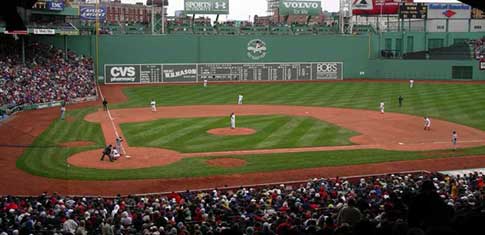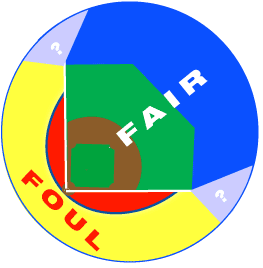
A first, simple look: fair is good and foul is bad
 |
| The foul lines separate fair from foul territory. The shape of those areas in a particular ball park depends on the layout of stands and walls. |
Fair territory: a baseball hit here usually results in it being declared a fair-ball, which is what the offense wants. This territory, strictly speaking, is the ground between the two long white lines (the foul lines), i.e. the green and brown of Diagram 2. It is either amusing or confusing that the lines are officially called the foul lines and the poles are called the foul poles even though they are all in fair territory, as is the wall that abuts the fair ground between the poles.
 |
| Diagram 2: A simple diagram of where the offense wants to hit the baseball. If it lands in the fair area, the batter may have a chance to proceed around the bases. |
Green represents what is traditionally, but not necessarily, the grass or artificial grass that lies in fair territory. The brown areas represent what is traditionally, but not necessarily, the dirt-covered portions of fair territory. (The photo, above, shows that there are grass and dirt areas inside and outside of the fair territory of Fenway Park, just as there are in most playing fields.)
Practically speaking, the blue, which represents the stands that extend beyond fair territory, is also a part of fair territory ... a very good part, for the offense, as we shall see on the next page.
Foul territory: a ball hit here is usually a foul-ball, which is usually bad or indifferent for the offense. Strictly speaking, it is the red of Diagram 2, i.e., the ground covered by either dirt or grass that is outside of the foul lines. Practically speaking, foul territory includes the yellow, which represents the stands that abut the ground in question.
The gray area of Diagram 2 is hard to label as fair or foul, good or bad for the offense, even though we are just taking a first, simple look. The reason is that, because of their trajectories, more or less half of the balls hit into the gray are eventually judged to be fair balls, and half are judged to be foul balls. We'll explain this in the next section (Fair and Foul-Balls).



